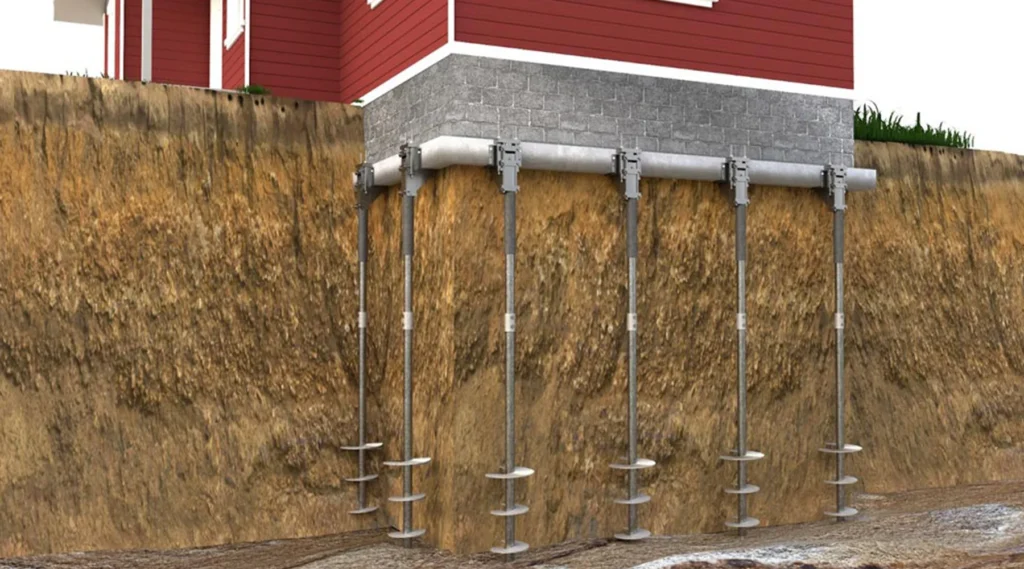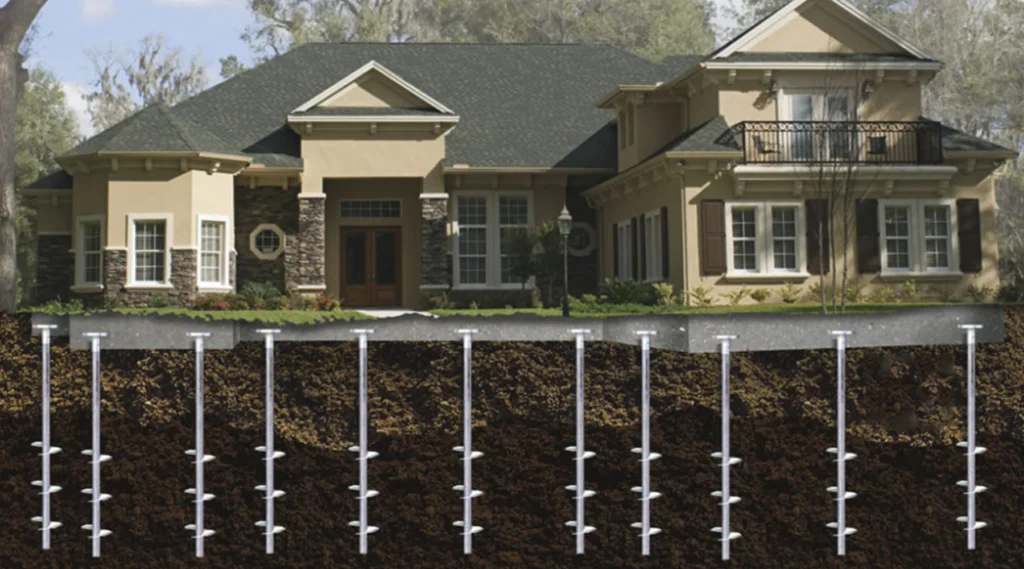A sinking or shifting foundation is more than just a crack in the wall — it’s a sign your home or building is losing its support. If left unchecked, foundation issues can lead to serious structural damage. That’s where helical pier foundation comes in. These modern, reliable tools offer a long-lasting fix for foundation settlement across homes and commercial buildings in Georgia, North Carolina, and South Carolina.
Let’s break down how helical pier foundation work and why they’re one of the most trusted soil stabilisation solutions available today.
What Causes Foundation Settlement?
Before we dive into the fix, let’s look at the root of the problem. Foundation settlement happens when the ground beneath your structure can no longer support its weight. That leads to sinking floors, cracked walls, or doors that no longer shut properly.
Soil Shifting & Erosion
One of the biggest reasons for settlement is unstable soil. Clay-heavy soil expands and contracts with moisture changes. Loose or poorly compacted fill soil can compress over time. These conditions cause your foundation to move and settle unevenly.
Drainage & Moisture Issues
Water is a silent threat to foundations. Poor drainage or heavy rain can wash away supporting soil. Over time, this leads to voids beneath the foundation and uneven support especially common in areas like Charleston, SC or Atlanta, GA, where seasonal rains are intense.
External Factors Like Tree Roots or Construction
Tree roots can dry out soil or even push against your foundation. Nearby construction or vibrations can also disrupt the soil structure. All of these contribute to foundation settlement.
What Are Helical Piers?
Helical piers are steel shafts with spiral plates (helices) that are twisted deep into the ground until they reach stable soil. They’re a go-to option for foundation underpinning — reinforcing or stabilising a structure that’s settled or at risk.
Components & How They Work
- Shaft: Long steel rod that acts as the support beam.
- Helical Plates: Spiral-shaped discs that anchor the pier as it’s driven into the ground.
- Brackets: Connect the pier to your existing foundation.
Once installed, the weight of your structure transfers to these deep supports, lifting and stabilising the foundation. It’s a precise, engineered approach to foundation lifting and levelling.
Why Helical Piers Work Better Than Traditional Methods
- No need for heavy excavation
- Work in any weather, any season
- Immediate load-bearing capacity
- Ideal for soft, shifting, or clay-heavy soils found throughout the Southeast
Compared to concrete piers or slab-jacking, helical piers installation is faster, cleaner, and more effective for long-term stability.
Installation Process of Helical Piers
Every home or building has unique soil and structural conditions. That’s why the process starts with careful planning.
Site Assessment & Soil Testing
- Evaluate the building’s current foundation condition
- Perform soil borings or tests to determine the depth of stable strata
- Develop a custom pier layout and depth plan
Step-by-Step Installation
- Expose the foundation footer
- Use hydraulic machinery to screw each helical pier deep into the soil
- Attach brackets to the foundation
- Transfer the load from the structure to the piers
- Lift and level the foundation as needed
Load Testing for Safety
Before the job is finished, each pier is tested to confirm it can handle the required load. This ensures long-term performance and safety.
Residential vs. Commercial Applications
Helical piers aren’t just for large buildings — they’re perfect for homes too. Whether it’s a sinking porch, cracked basement wall, or full-structure settlement, there’s a pier solution for every scenario.
When to Use Helical Piers at Home
- Uneven floors
- Cracks in drywall or brick
- Gaps around windows or doors
- Tilting chimneys or stoops
- Basement walls bowing or shifting
Industrial & Commercial Use Cases
- Warehouses and retail stores
- Multi-story buildings
- New construction on soft soils
- Pre-engineered metal buildings
In commercial settings, they’re ideal for foundation underpinning during renovations or load increases.
Benefits of Using Helical Piers
Helical piers offer several benefits for foundation support and repair, including quick and cost-effective installation, minimal site disturbance, and superior load-bearing capacity, some of the benefits are :
Fast Installation & Minimal Disruption
Most jobs are completed in just a few days. No large excavation means less mess and faster cleanup. Great for occupied homes and busy commercial sites.
Long-Term Foundation Stability
Since helical piers anchor into deep, stable soil, they provide lasting support. They also protect against future shifting and erosion — a major concern in flood-prone or moisture-heavy areas.
Cost-Effectiveness & ROI
Helical piers often save money in the long run by avoiding recurring repairs. They also boost property value by restoring structural integrity — a key benefit for both homeowners and investors.
Why Choose Tri-State Waterproofing for Helical Piers?
We’ve helped hundreds of property owners across Georgia, North Carolina, and South Carolina solve their foundation problems — from Greenville to Charlotte, from Atlanta to the coast.
Expertise in Gainesville & the Southeast
Our team knows the local soil conditions inside and out. That means smarter assessments, more accurate pier depths, and better long-term outcomes.
Licensed Installers & Proven Success Rate
Tri-State Waterproofing’s crews are trained, licensed, and experienced in complex helical piers installation. We don’t just fix the problem — we engineer a solution built to last.
Got signs of foundation settlement? Don’t wait for the cracks to spread. Contact Tri-State Waterproofing today to schedule a site inspection and learn more about how helical piers can stabilize your home or commercial building — for good.


